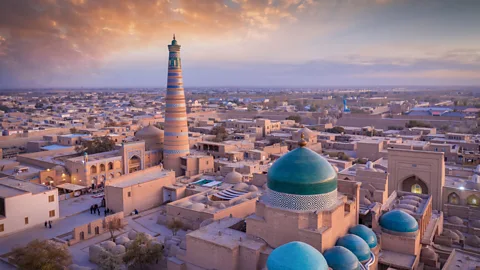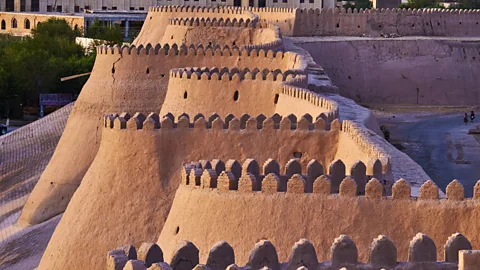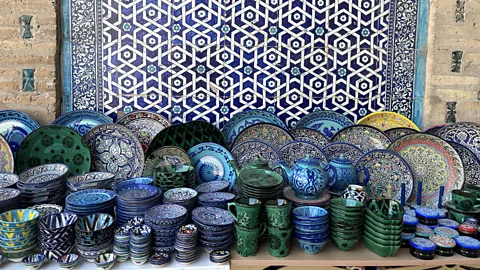Khiva: The Silk Road city most tourists miss
 Mlenny/Getty Images
Mlenny/Getty ImagesOnce an important oasis welcomed by weary travellers – and equally feared for its reputation for ruthless slave trading – Khiva is undeservedly overshadowed by Bukhara and Samarkand.
In the small town of Khiva in Uzbekistan, bounded by the Karakum and Kyzylkum deserts, all roads lead to a walled fortress known as Itchan Kala. That's because everything that's worth seeing and experiencing in Khiva is contained within the walls of this citadel. It's home to more than 60 cultural sites, medieval mosques and opulent palaces, as well as numerous museums, souvenir shops and craft studios.
The Itchan Kala is where I was headed bright and early one autumn morning. Entering from the Ota Darwza, or the West Gate, located close to the ticket counter, I could see the street shops slowly coming to life: the chugirma vendor was fluffing up his collection of sheepskin fur hats used by locals to keep their heads warm in the bitter winters; the woman selling traditional ikat-print chapans (long coats) lured me with a striking black-and-white jacket; the master woodcarver was sitting on his chair, head bent over what looked like an intricately chiselled cheeseboard; the carpet weaver briefly looked up from the loom to smile at me before bending her head back to study the pattern.
But the roads were strangely empty. Where were all the tourists?
Along with Bukhara and Samarkand, Khiva – locally pronounced "Heevah" – forms Uzbekistan's troika of Silk Road cities. But only the two former have become popular among tourists, due to their proximity to the capital city of Tashkent. Just a mention of those names is enough to evoke images of a time when these cities were at the heart of the influential network of trading routes stretching from China all the way to Rome and Venice. For much of those 1,500 years, roughly from 130 BCE until 1453 CE, this central Asian region saw the exchange of not just silks and spices, but all kinds of ideas and philosophies.
 Tuul & Bruno Morandi/Getty Images
Tuul & Bruno Morandi/Getty ImagesThere is archaeological evidence to show that Khiva has existed since the 6th Century CE. It became a significant trading post on the Silk Road and rose to even more prominence within the region in the 1600s when it became the capital of the Khanate (kingdom of the Khan rulers).
At its peak, Khiva was a welcoming oasis for weary travellers, who were undeterred by Khiva's fearsome reputation for slave trading. Having already crossed the Kyzulkum desert on their way from Bukhara, these merchants and traders halted in Khiva for rest and refreshment and to load up their caravans with essential supplies before heading off into the vast stretch of unforgiving desert towards Persia. In its Silk Road Programme, Unesco describes Khiva as a "centre of education, science and culture, and served as a cradle of civilisations spanning millennia".
Given this history, I was surprised by how modern-day Khiva seems to get only a fraction of the tourists who throng Samarkand and Bukhara. But I wasn't complaining, happy to have these magnificent sites mostly to myself.
Before the Itchan Kala became a Unesco World Heritage site in 1990, the government relocated residents outside the fortress walls in order to preserve and restore the monuments that had fallen in disrepair. Today, the Itchan Kala is an enchanting city inside a city and a living museum that has been extensively restored as an open-air showcase of regional history.
Behzad Larry, CEO of Voygr Expeditions, a company specialising in responsible travel to central Asia, describes Khiva as a "living relic amidst the desert expanse" and "[an] ancient city that beckons travellers to step back in time". He explained that the self-contained design of Itchan Kala offers visitors a chance for a more intimate exploration of its landmarks as well as meaningful interactions with the local community.
 Charukesi Ramadurai
Charukesi Ramadurai"Khiva exudes an unmistakable aura of antiquity that sets it apart from its more renowned Silk Road counterparts like Bukhara and Samarkand, where the old harmoniously coexists with the new," he added. Having visited both Bukhara and Samarkand, where the monuments are scattered around what are now modern cities bustling with traffic, I could see what he meant.
Although locals don't live within the fortress, they come here every day to their studios, shops, restaurants and teahouses to work. As I walked through Khiva's narrow lanes, I discovered an embarrassment of riches: a teal-tiled palace here, a multi-pillared mosque there; a life-size street statue of two men chatting merrily with the samovar bubbling away at their feet; a carpet-weaving workshop next to a ceramic studio. In a museum inside the Kunya-Ark citadel, exhibits explained how concepts like algebra and algorithm have roots in this part of the world, and particularly in the work of Khiva-born mathematician Muhammad ibn Musa al-Khwarizmi.
Anita Sethi Ramakrishna, an Indian who has been living in Tashkent for the past few years and has travelled extensively through Uzbekistan, told me that exploring Khiva makes her feel like a small child. "I feel like Alice in Wonderland, wandering through the labyrinth of tiny lanes that suddenly open into wide squares, and coming across craftsmen and traders selling their wares."
 Charukesi Ramadurai
Charukesi RamaduraiI got it. Despite the city's sprawl of 26 hectares, the touristic heart of Itchan Kala was compact and easily navigable on foot. And each time I thought I had been on the same road before, I found myself turning a different corner and coming across a new monument or mausoleum. Or an unfinished minaret like the squat Kalta Minor, bedecked with glazed majolica tiles in stunning shades of teal and turquoise.
My absolute favourite was the Tosh Hauli, or stone palace, built by Allakuli Khan in the mid-1830s and tucked away in a corner towards the northern gate. The tiles in the rooms and courtyards of the harem area where the Khan lived with his four wives and 40 concubines, had some of the most exquisite colours and patterns found anywhere in the Itchan Kala, drawing me back again and again for closer inspection.
The Kunya-Ark citadel, which is other major palace complex here, dates to the 12th Century and contains a throne room, a mint, stables and a beautiful summer mosque with blue wall tiles and a brown, orange and gold ceiling. I visited the Ark late in the evening and climbed up the steep and narrow steps of the watchtower in search of Khiva's famed desert sunset.
"Dusk is my favourite time in Khiva," Larry had told me, "because as the sun sets gradually, the city walls unveil a final gift: a panoramic view of the ancient skyline, bathed in a golden hue." Having huffed and puffed my way to the top, I was treated to a 360-degree view of not just the monuments within the Itchan Kala, but also the town that lay beyond its walls. The desert sunset was indeed spectacular, a bold palette of pinks and oranges tinged with gold.
 Charukesi Ramadurai
Charukesi RamaduraiWhile most of the old monuments inside the Itchan Kala have been restored to their former glory, the former madrasahs (Islamic schools) have been repurposed into craft workshops or souvenir markets. Whenever I stopped to look, ire or just take photos, I noticed no irritation among the vendors; there was no hard-sell, no aggression. Everything somehow seemed slower here, everyone calmer. I found myself mentally discarding the must-see list I had made earlier, and I surrendered myself to serendipity.
As Sethi Ramakrishna said, "There is no pressure here like in the larger towns – you can take your time and sit down to sip an Uzbek lemon tea, and see the vendors making their sales and young couples having a photoshoot. And wonder how the caravans of yore found their way to this beautiful place on the Silk route."
I followed her lead and settled down for some people-watching at an al fresco choyxona (teahouse) just opposite Kalta Minor. The Silk Road itself may be a thing of the past, its relevance wiped away by the advent of more convenient sea routes. But sitting here in a corner of Khiva, I knew for sure that its legacy lives on.
---
more than three million BBC Travel fans by liking us on Facebook, or follow us on Twitter and Instagram.
If you liked this story, window._taboola = window._taboola || []; _taboola.push({ mode: 'alternating-thumbnails-a', container: 'taboola-below-article', placement: 'Below Article', target_type: 'mix' });
